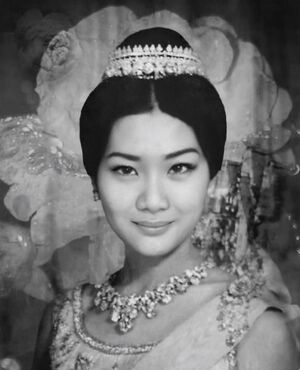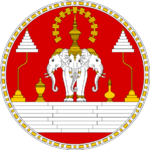User:Belfras/AnulaofAnkat: Difference between revisions
No edit summary |
mNo edit summary |
||
| Line 39: | Line 39: | ||
|}} | |}} | ||
'''Anulā''' ({{wpl|Sinhala|Terasi}}:''විජාලන්යා ගේ නිවසේ රවීන්ගේ සහ ආර්න්ගේ දියණිය අනුලා, <small>tr</small>; Vijālanyā gē nivasē Ravīngē saha ārngē diyaṇiya Anulā''; 5 July 1926 - 7 March 1968) was the last queen of the [[Royal Kingdom of Ankat]] and the fifth queen of the country. She ruled from 1950 after her father's death until | '''Anulā''' ({{wpl|Sinhala|Terasi}}:''විජාලන්යා ගේ නිවසේ රවීන්ගේ සහ ආර්න්ගේ දියණිය අනුලා, <small>tr</small>; Vijālanyā gē nivasē Ravīngē saha ārngē diyaṇiya Anulā''; 5 July 1926 - 7 March 1968) was the last queen of the [[Royal Kingdom of Ankat]] and the fifth queen of the country. She ruled from 1950 after her father's death until 1968 when during the [[Ankati Revolution]] she was killed. Her reign has been subject to many historical debates as documents from her time as queen have largely been destroyed during the sack of the Royal palace shortly after her death. The current government of the [[Ankat|Socialist Republic of Ankat]] has stated and procured documents stating that Queen Anulā instigated multiple instances of human rights abuses, with the [[1967 Tan Mar Massacre]], a widely documented incident between royal forces and protestors in [[Tan Mar]] in the months leading up to the revolution being the most widely documented. Despite evidence shown by the socialist government, many commentators insist that the Tan Mar massacre was conducted by overzealous military commanders operating without orders and that other accusations by the socialist government are unfounded, with some pieces of evidence being exposed as fraudulent. | ||
In her life she was often referred to as a modernising influence for the country, overseeing overhauls within the nations cities that helped turn [[Nilagne Naegima]], the nations capital, into a flourishing metropolis for the region by the turn of the century and her influences can still be felt today in the modern artwork seen throughout the country. She followed lessons of her father in cultivating relations with [[Mutul]], [[Pulau Keramat]] and select nations both in the region and in [[Belisaria]], where she often vacationed and had purchased a summer house in XXXX. She was the only child of her father, Ravin III, and as the crown princess had ownership of the [[Sasrika Kanda|Saśrīka Kanda]], or Flourishing Hill. A large estate in the Simhaya mountains. | In her life she was often referred to as a modernising influence for the country, overseeing overhauls within the nations cities that helped turn [[Nilagne Naegima]], the nations capital, into a flourishing metropolis for the region by the turn of the century and her influences can still be felt today in the modern artwork seen throughout the country. She followed lessons of her father in cultivating relations with [[Mutul]], [[Pulau Keramat]] and select nations both in the region and in [[Belisaria]], where she often vacationed and had purchased a summer house in XXXX. She was the only child of her father, Ravin III, and as the crown princess had ownership of the [[Sasrika Kanda|Saśrīka Kanda]], or Flourishing Hill. A large estate in the Simhaya mountains. | ||
Revision as of 11:34, 4 January 2022
| Anulā | |||||
|---|---|---|---|---|---|
 | |||||
| Queen of Ankat (more...) | |||||
| Reign | 16 December 1950 – 7 March 1968 (17 years, 2 months, 20 days) | ||||
| Coronation | 20 December 1950 | ||||
| Predecessor | Ravin III | ||||
| Successor | Monarchy abolished | ||||
| Prime Ministers | |||||
| Born | 5 July 1926 Royal Palace, Nilagne Naegima, Ankat | ||||
| Died | 7 March 1968 (age 41) Royal Palace, Nilagne Naegima, Ankat | ||||
| Consort | XXXX (m. 1945) | ||||
| Issue |
| ||||
| |||||
| House | House of Vijalanya | ||||
| Father | Ravin III | ||||
| Mother | Queen Consort Aryen | ||||
| Religion | Sudu Mārgaya | ||||
Anulā (Terasi:විජාලන්යා ගේ නිවසේ රවීන්ගේ සහ ආර්න්ගේ දියණිය අනුලා, tr; Vijālanyā gē nivasē Ravīngē saha ārngē diyaṇiya Anulā; 5 July 1926 - 7 March 1968) was the last queen of the Royal Kingdom of Ankat and the fifth queen of the country. She ruled from 1950 after her father's death until 1968 when during the Ankati Revolution she was killed. Her reign has been subject to many historical debates as documents from her time as queen have largely been destroyed during the sack of the Royal palace shortly after her death. The current government of the Socialist Republic of Ankat has stated and procured documents stating that Queen Anulā instigated multiple instances of human rights abuses, with the 1967 Tan Mar Massacre, a widely documented incident between royal forces and protestors in Tan Mar in the months leading up to the revolution being the most widely documented. Despite evidence shown by the socialist government, many commentators insist that the Tan Mar massacre was conducted by overzealous military commanders operating without orders and that other accusations by the socialist government are unfounded, with some pieces of evidence being exposed as fraudulent.
In her life she was often referred to as a modernising influence for the country, overseeing overhauls within the nations cities that helped turn Nilagne Naegima, the nations capital, into a flourishing metropolis for the region by the turn of the century and her influences can still be felt today in the modern artwork seen throughout the country. She followed lessons of her father in cultivating relations with Mutul, Pulau Keramat and select nations both in the region and in Belisaria, where she often vacationed and had purchased a summer house in XXXX. She was the only child of her father, Ravin III, and as the crown princess had ownership of the Saśrīka Kanda, or Flourishing Hill. A large estate in the Simhaya mountains.
Following the revolution her legacy has been subject to debate and differences of opinion steeping into the viewers bias toward the socialist movement or to the monarchist cause. For the socialists she is viewed as a tyrannical leader who, they say, directly ordered masses of executions and ordered her troops to conduct the 1967 Tan Mar Massacre and personally ordered the execution of Vimukthi Ratnam, her former Prime Minister and leader of the Torists. To the monarchists she is seen as a queen who, despite doing great things for her people was ultimately a victim of overzealous commanders who covered up their mistakes until, ultimately, the Torists led the revolution against her. Anulā and her eldest son, Prince Nimal, were killed when members of the Kaha Mal sacked the Royal Palace during the First Battle of Nilagne Naegima at the start of the Ankati Civil War. Senior members of her Royal Guard fled the palace with her remaining children, although with the palace being burnt down and a socialist victory in the civil war, the monarchy effectively ended with Anulā's death.
Early Life
Anulā was born on the 5th of July 1926 to King Ravin III of the House of Vijalanya and to mother Ayren of the House of Vinjan at the Royal Palace as their only child.
Queen of Ankat
Legacy
Titles, styles, honors and arms
| Styles of The Queen | |
|---|---|
 | |
| Reference style | Her Majesty |
| Spoken style | Your Majesty |
Styles of address
- 5 July 1926 - 16 December 1950: Her Royal Highness the Crown Princess
- 16 December 1950 – 7 March 1968: Her Majesty the Queen
Decorations
Awards
Issue
| Name | Birth | Death | Spouses |
|---|---|---|---|
| By XXXX (b. XXXX): | |||
| Nimal | 14 February 1949 | 7 March 1968 (age 18) | N/A |
| Juyanti | 18 October 1952 | 23 April 1999 (age 46) | |
| Sihad | 11 March 1955 | ||
| Jihan | 6 August 1963 | ||
See also
Belfras/AnulaofAnkat Born: 5 July 1926 Died: 7 March 1968
| ||
| Royal titles | ||
|---|---|---|
| Preceded by Ravin III |
Queen of Ankat 1950-1968 |
Monarchy abolished |

